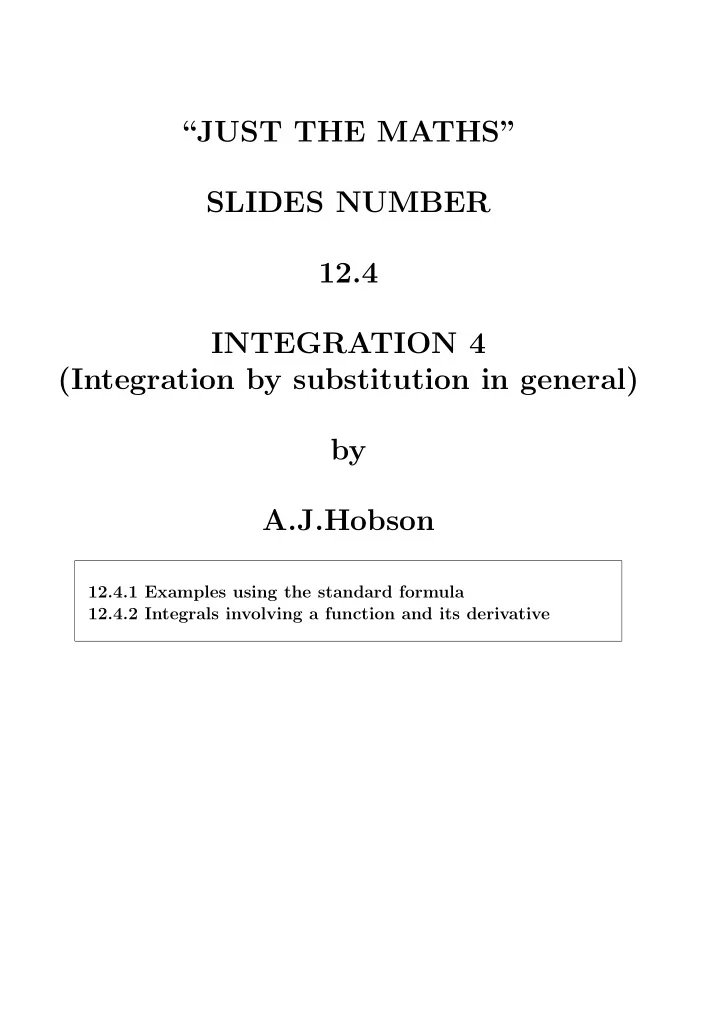

“JUST THE MATHS” SLIDES NUMBER 12.4 INTEGRATION 4 (Integration by substitution in general) by A.J.Hobson 12.4.1 Examples using the standard formula 12.4.2 Integrals involving a function and its derivative
UNIT 12.4 - INTEGRATION 4 INTEGRATION BY SUBSTITUTION IN GENERAL 12.4.1 EXAMPLES USING THE STANDARD FORMULA With any integral � f ( x )d x we may wish to substitute for x in terms of a new variable, u . From Unit 12.1, � f ( x )d x = � f ( x )d x d u d u. This result was originally used for Functions of a Linear Function. For this Unit, substitutions other than linear ones will be illustrated. 1
EXAMPLES 1. Use the substitution x = a sin u to show that d x a 2 − x 2 = sin − 1 x � √ a + C. Solution We shall assume that u is the acute angle for which x = a sin u . In effect, we substitute u = sin − 1 x a using the principal value of the inverse function. If x = a sin u , then d x d u = a cos u so that the integral becomes a cos u � √ a 2 − a 2 sin 2 u d u. But, from trigonometric identities, � a 2 − a 2 sin 2 u ≡ a cos u, both sides being positive when u is an acute angle. Thus, we have � 1d u = u + C = sin − 1 x a + C. 2
2. Use the substitution u = 1 x to determine the indefinite integral d x � √ z = 1 + x 2 . x Solution Writing x = 1 u, we have d x d u = − 1 u 2 . Hence, 1 . − 1 � z = u 2 d u. � 1 1 + 1 u 2 u That is, √ � − 1 u 2 + 1) + C. √ z = u 2 + 1 = − ln( u + Thus, � 1 � 1 � � z = − ln x + x 2 + 1 + C. � � 3
12.4.2 INTEGRALS INVOLVING A FUNCTION AND ITS DERIVATIVE Two useful results: (a) � [ f ( x )] n f ′ ( x )d x = [ f ( x )] n +1 + C n + 1 provided n � = − 1. (b) � f ′ ( x ) f ( x ) d x = ln f ( x ) + C. These two results are obtained from the substitution u = f ( x ) . In both cases, d u d x = f ′ ( x ) . Hence, d x 1 d u = f ′ ( x ) . 4
This converts the integrals, respectively, into (a) � u n d u = u n +1 n + 1 + C, and (b) � 1 u d u = ln u + C. EXAMPLES 1. Evaluate the definite integral � π sin 3 x. cos x d x. 3 0 Solution In this example, we can consider sin x to be f ( x ) and cos x to be f ′ ( x ). Thus, by result (a), π sin 4 x = 9 3 � π 0 sin 3 x. cos x d x = 64 , 3 4 0 √ using sin π 3 3 = 2 . 2. Integrate the function 2 x + 1 x 2 + x − 11 5
with respect to x . Solution Here, we can identify x 2 + x − 11 with f ( x ) and 2 x +1 with f ′ ( x ). Thus, by result (b), 2 x + 1 x 2 + x − 11d x = ln( x 2 + x − 11) + C. � 6
Recommend
More recommend